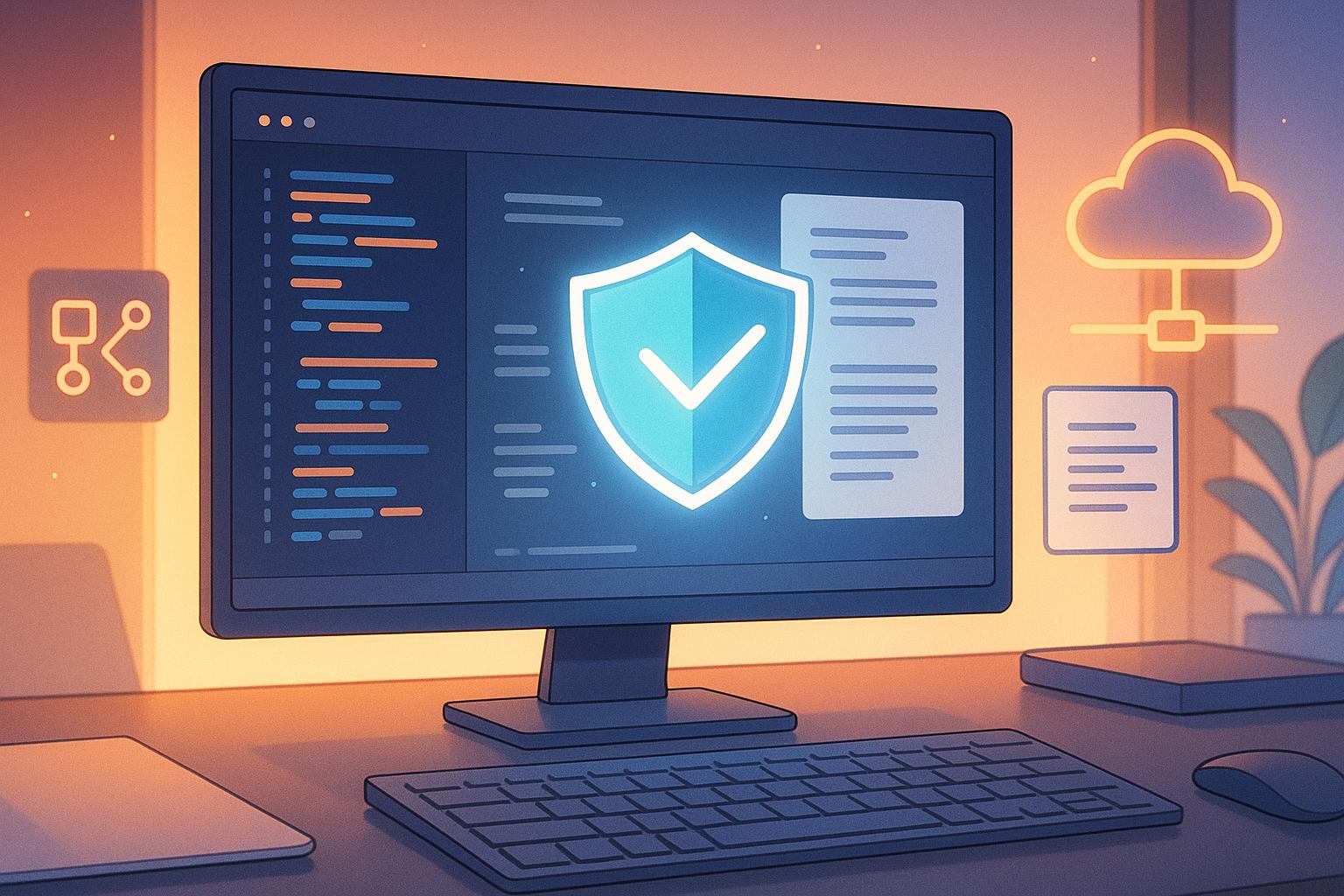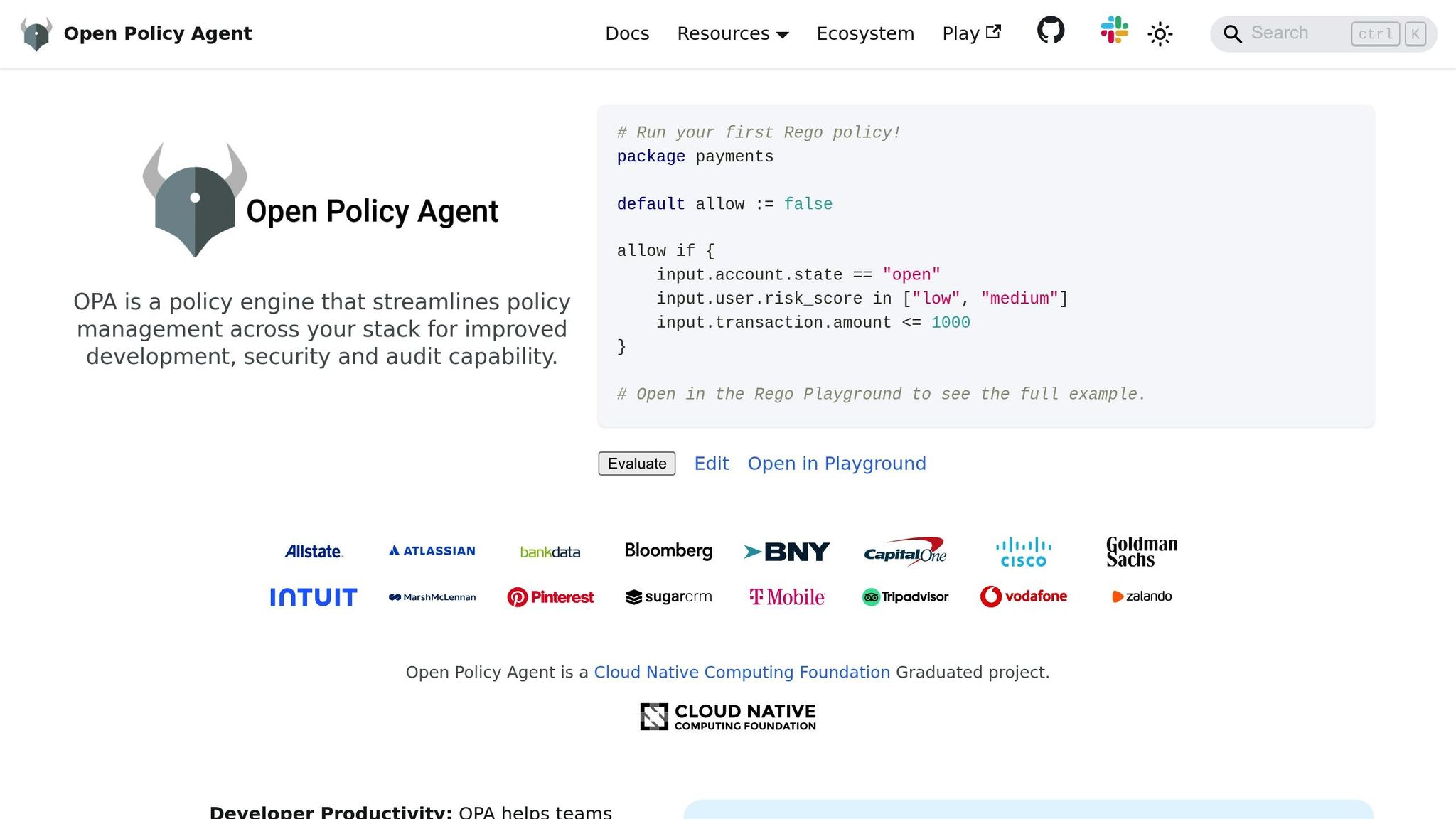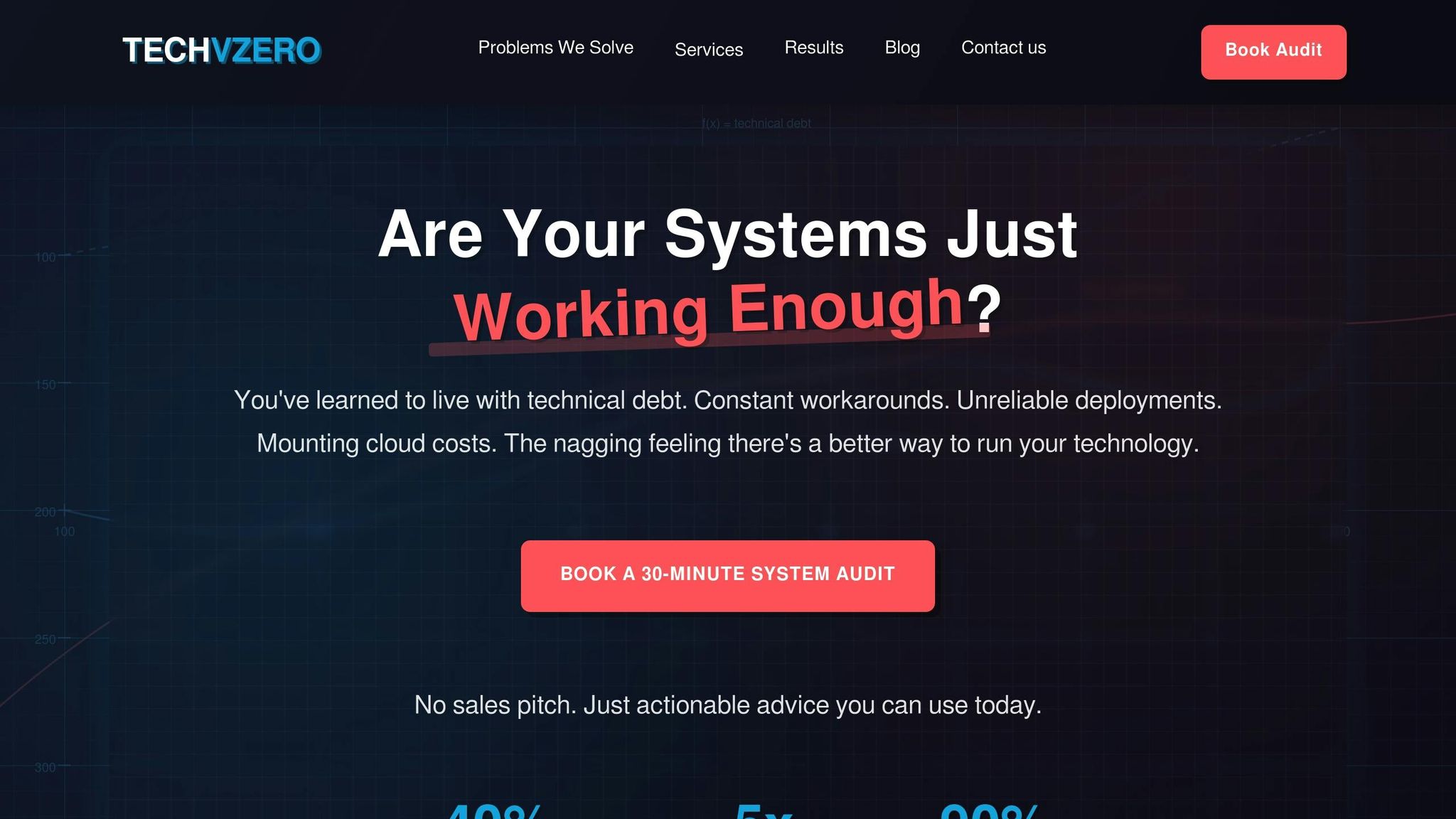Policy-as-Code Best Practices for Security

Policy-as-Code (PaC) automates security and compliance by turning policies into executable code. This ensures consistent enforcement across cloud environments, reduces manual errors, and integrates seamlessly into DevOps workflows. Key practices include:
- Focus on high-impact policies: Start with rules like encryption and access controls to address critical vulnerabilities.
- Automate enforcement: Use CI/CD pipelines and real-time tools to catch and block violations early.
- Continuous monitoring: Track changes, log violations, and maintain audit trails for compliance.
- Test policies: Simulate and validate policies in non-production environments before full rollout.
- Encourage collaboration: Involve security, development, and operations teams to ensure policies are practical and effective.
Popular tools like Open Policy Agent (OPA), Kyverno, and cloud-native services (e.g., AWS Config, Azure Policy) help implement PaC. Choose tools based on compatibility, team expertise, and integration needs. TECHVZERO simplifies this process by automating policy enforcement, optimizing cloud costs, and providing ongoing support.
Implementing Policy as Code through Open Policy Agent

Policy-as-Code Best Practices Checklist
Getting Policy-as-Code (PaC) right requires more than just tools – it’s about creating a strategy that balances security with efficiency. Below are key practices to help your organization build a solid foundation while avoiding common hurdles.
Start with High-Impact Policies
Focus on policies that deliver quick, measurable security benefits. Start with compliance-driven rules like SOC 2, PCI DSS, or HIPAA. For example, enforcing S3 bucket encryption is a clear, actionable policy that ensures compliance.
Address frequent security issues your organization faces. If misconfigured security groups are a recurring headache, prioritize network access policies. Tackling these high-impact areas first allows teams to see immediate results. Once these policies are in place, automate their enforcement to maintain consistency and reduce manual effort.
Automate Policy Enforcement
Integrating PaC into your CI/CD pipelines is a game-changer. This setup can block severe violations early and issue warnings for less critical issues, preventing problems from reaching production.
Use policy-as-code scanning tools to validate infrastructure-as-code templates (e.g., Terraform, CloudFormation, ARM) before they spin up resources in the cloud. Catching violations early saves time and money.
For live environments, consider real-time enforcement with tools like admission controllers or cloud-native policy engines. These can safeguard against changes made outside the usual CI/CD workflow, such as emergency fixes or manual updates.
Set Up Continuous Monitoring and Auditing
Environments change constantly, and continuous monitoring ensures compliance stays intact. Use real-time policy evaluation to catch configuration changes that deviate from your security standards, whether intentional or accidental.
Automate fixes for common issues, like enabling logging or adding tags, to minimize manual intervention. For more complex violations, trigger alerts for manual review.
Keep detailed audit trails to log policy evaluations, violations, and remediation actions. These logs are invaluable for compliance audits and provide insights into recurring issues. Make sure your logs include timestamps, affected resources, violation details, and remediation steps.
Configure alerting thresholds to strike a balance between visibility and noise. Send immediate alerts for critical issues while batching lower-priority ones into daily or weekly summaries. This approach prevents alert fatigue while ensuring urgent matters get the attention they need.
Test Policies Before Production
Before rolling out policies, test them in environments that mimic production. Use dry-run capabilities to simulate policy enforcement without making actual changes. This allows you to identify potential issues risk-free.
Adopt staged rollouts to introduce new policies gradually. Start with a monitoring-only phase, then increase enforcement over time. This phased approach helps uncover edge cases without disrupting operations.
Include policy regression testing in your workflow. When updating policies, test them against known configurations – both good and bad – to ensure they work as intended. This prevents accidental gaps in enforcement. Once policies are validated, focus on organization-wide adoption by encouraging collaboration across teams.
Promote Cross-Team Collaboration
Effective PaC requires breaking down silos. Involve security, development, and operations teams in policy creation. Joint policy development sessions ensure that policies are both secure and practical for implementation.
Adopt a shared responsibility model: security teams define the intent of policies, while development teams provide insights into how they can be implemented effectively. This collaborative approach ensures policies meet security requirements without hindering workflows.
Schedule regular policy reviews with all stakeholders. Quarterly reviews are a good starting point for assessing policy effectiveness, addressing new needs, and retiring outdated rules. These sessions help keep policies aligned with evolving business goals and security challenges.
Enable self-service policy tools so development teams can test their configurations independently. Clear documentation and examples make it easier for teams to understand policy requirements and fix issues on their own.
Finally, foster a culture of shared ownership. Security isn’t just the responsibility of one team – it’s everyone’s job. Recognize teams that consistently meet compliance standards and provide extra training for those who struggle. This shared accountability helps build a stronger, more secure organization.
Tools and Technologies for Policy-as-Code Implementation
Selecting the right tools is a critical step in successfully implementing Policy-as-Code. The options range from open-source platforms to cloud-native solutions, each offering unique features and benefits.
Key Policy-as-Code Tools
Open Policy Agent (OPA) is a standout in the Policy-as-Code space. It’s an open-source tool that uses the Rego query language and supports various environments, including Kubernetes clusters and Terraform deployments. Its tool-agnostic nature allows it to integrate seamlessly with infrastructure-as-code tools like Pulumi, AWS CloudFormation, and Kubernetes. While Rego can be complex, OPA’s broad compatibility makes it a top choice for many organizations.
Kyverno simplifies policy enforcement by using YAML, avoiding the need to learn a new policy language. It’s specifically designed for Kubernetes, but its smaller community may result in fewer resources for learning and troubleshooting compared to OPA.
Cloud-native policy services are tightly integrated with their respective platforms. For example:
- AWS Config offers cost-effective solutions for small-scale deployments, with pricing based on configuration items and active rules.
- Azure Policy is bundled with Azure services, with costs tied to the number of monitored resources.
These tools are excellent for enforcing platform-specific compliance but may lack the flexibility needed for multi-cloud environments.
Pulumi CrossGuard allows policies to be written in familiar programming languages like TypeScript, Python, Go, and .NET. This feature is especially appealing to development teams that want to avoid learning a domain-specific language like Rego. However, CrossGuard is primarily designed to work within Pulumi’s infrastructure-as-code framework, running policies before resource provisioning.
KICS (Keeping Infrastructure as Code Secure) by Checkmarx is an open-source tool under the Apache 2.0 license. It performs static analysis on infrastructure-as-code templates, identifying security vulnerabilities and compliance issues before deployment.
Spacelift provides a robust platform supporting OPA and Rego while remaining tool-agnostic. It works across various infrastructure-as-code solutions and offers a free tier for smaller teams, with scalable pricing for larger organizations. Its flexibility makes it a strong contender for teams managing diverse environments.
How to Choose the Right Tool
Once you’re familiar with the available tools, the next step is aligning them with your organization’s specific needs. Start by clarifying your requirements and defining the policies you aim to implement. Evaluate how these policies align with your business goals, industry standards, and security needs. Document the purpose, scope, and enforcement responsibilities for each policy, along with the potential consequences of non-compliance.
When evaluating tools, consider the following factors:
- Technical compatibility: Ensure the tool integrates well with your existing infrastructure and technologies.
- Team expertise: Match the tool’s complexity to your team’s skill set. For instance, open-source tools like OPA and KICS may require more in-house expertise, while enterprise solutions often come with additional support and features.
- Community and support: A strong community or vendor support can make a significant difference in troubleshooting and adoption.
- Ease of integration: Choose tools that fit seamlessly into your CI/CD pipelines and workflows without requiring major architectural changes.
- Usability: Tools with clear documentation and intuitive interfaces are more likely to gain traction with DevOps and security teams.
Start small by implementing a few high-priority policies. This approach allows your team to gain experience and confidence before scaling up to more complex use cases. Focusing on policies that offer immediate, measurable benefits can also help secure broader organizational buy-in.
sbb-itb-f9e5962
Common Policy-as-Code Use Cases
Policy-as-Code plays a crucial role in automating security processes, reducing risks, and ensuring compliance in key areas of cloud and software development.
Infrastructure Compliance Management
One of the most impactful applications of Policy-as-Code is enforcing encryption standards. For example, policies can mandate server-side encryption for S3 buckets, encryption at rest for RDS databases, and default encryption for EBS volumes. These measures ensure that sensitive data isn’t accidentally deployed without proper protection.
Network security policies are another essential area. They validate that security groups block unrestricted access (e.g., 0.0.0.0/0) on critical ports like SSH (22) and RDP (3389). Other policies ensure databases are deployed in private subnets and enforce HTTPS for load balancers to secure data in transit.
Resource tagging and governance policies help maintain consistency across cloud environments by requiring mandatory tags such as cost center, environment (e.g., dev, staging, prod), owner, and project. This approach simplifies resource management and enables accurate cost tracking, especially in large organizations.
To address potential configuration drift, policies ensure critical settings remain unchanged after deployment. For instance, they can enforce that CloudTrail logging stays enabled across all regions, providing continuous visibility into account activity.
Security checks integrated into CI/CD pipelines further enhance compliance and security measures.
CI/CD Pipeline Security
In CI/CD workflows, container image scanning policies ensure that only secure images are deployed. These policies block any images with high-severity vulnerabilities or outdated scans, integrating seamlessly with vulnerability scanners to maintain high security standards.
Code quality gates add another layer of protection by enforcing security requirements before code reaches production. Policies can require static code analysis, ensure no secrets are hardcoded in configuration files, and mandate proper documentation and approval for infrastructure changes.
Deployment validation ensures that production deployments are handled securely. For example, policies might restrict deployments to authorized users, enforce maintenance window schedules, or require rollback procedures for added safety.
Third-party dependency management is also critical. Policies can identify vulnerabilities in external libraries or packages, block builds with outdated dependencies, and require security team approval for new integrations.
By addressing these areas, organizations can secure their pipelines while maintaining efficient workflows. Next, let’s look at how access controls can further strengthen security.
Access Control and Role Validation
To prevent privilege escalation, policies enforce least-privilege principles for IAM roles. They can flag overly permissive roles, identify unused permissions, and block administrative privileges unless properly justified.
Temporary access management ensures elevated permissions are time-limited. Policies can revoke temporary credentials after a set period, require periodic access reviews, and enforce proper rotation of sensitive credentials.
Cross-account access validation ensures secure resource sharing between AWS accounts. Policies can block unintended public access, require encryption for cross-account data transfers, and validate that shared resources maintain strict access controls.
For service account governance, policies manage the lifecycle of service accounts and API keys. This includes enforcing regular credential rotation, preventing long-lived access keys, and ensuring service accounts are tied to specific applications or functions.
These examples highlight how Policy-as-Code transforms security from a manual, reactive approach into a proactive and automated system. By applying these policies, organizations can significantly reduce risks while maintaining the speed and flexibility modern development demands.
Policy-as-Code with TECHVZERO‘s DevOps Solutions

TECHVZERO takes Policy-as-Code to the next level by seamlessly integrating it into DevOps workflows. By embedding security policies directly into development processes, they ensure that compliance and efficiency go hand in hand.
Improving Security Through Automation
With TECHVZERO’s DevSecOps approach, security becomes an integral part of every stage – from planning to production. Their automated CI/CD processes validate configurations, scan container images, and enforce access controls. If a deployment doesn’t meet compliance standards, it’s automatically blocked, with clear steps provided for remediation.
Leveraging Infrastructure-as-Code (IaC), TECHVZERO eliminates the risk of configuration drift by using version-controlled deployments. This ensures that security policies are consistently applied across all environments without the need for manual intervention. Their automation reduces manual security tasks by over 80% and introduces self-healing systems that monitor infrastructure and fix common problems automatically.
This level of automation transforms traditional security checklists into actionable, operational success.
Optimizing Cloud Performance and Costs
TECHVZERO doesn’t just focus on security – they also help businesses optimize cloud performance and reduce costs. In fact, clients often see a 40% drop in cloud expenses within just 90 days. This is achieved by cutting resource waste, right-sizing instances, and enforcing cost allocation tags.
Their policy automation ensures that security measures don’t slow down system performance. For example, TECHVZERO implements policies to scale resources automatically based on demand, fine-tune database configurations, and balance traffic – all while maintaining strict security standards.
When it comes to compliance, TECHVZERO has it covered. They help organizations meet requirements for frameworks like SOC 2, HIPAA, and PCI DSS without stifling innovation. By classifying sensitive data, applying encryption policies, and maintaining detailed audit trails, they reduce compliance headaches while keeping operations secure. Proactive enforcement of these policies also leads to 90% less downtime, with monitoring systems offering timely and actionable insights.
Complete Implementation and Support
TECHVZERO provides a full-service approach to Policy-as-Code, handling everything from custom policy design and tool setup to team training and ongoing support. By building on proven methods, they deliver measurable improvements in security, performance, and cost management.
Their continuous improvement services ensure that Policy-as-Code strategies evolve as business needs change. TECHVZERO regularly evaluates policy performance, identifies areas for improvement, and implements updates to enhance both security and operational efficiency. They rely on data-driven metrics to track ROI and guide future enhancements.
With robust monitoring and incident response capabilities, TECHVZERO ensures that Policy-as-Code systems remain reliable 24/7. Automated monitoring tools track policy effectiveness and address common issues, while expert support is available for more complex situations.
This comprehensive approach not only reduces cloud costs and speeds up deployments but also strengthens security and lowers operational burdens. By partnering with TECHVZERO, organizations can fully unlock the benefits of Policy-as-Code while staying focused on their core goals.
Key Takeaways for Policy-as-Code Implementation
Policy-as-Code transforms cloud security by shifting from reactive measures to proactive, automated processes for your infrastructure. Success hinges on treating security policies as dynamic code that adapts to your business needs while upholding strict compliance standards.
Start small and scale smartly. Begin with high-priority policies that address critical vulnerabilities, then gradually expand as your team becomes more comfortable with the approach. Ensure thorough validation to confirm policies work as intended before rolling them out widely.
Automation is your secret weapon. By adopting Policy-as-Code, organizations see noticeable improvements in both security and operational efficiency. Automation enforces consistent policies across all environments, eliminating configuration drift and reducing human error – one of the leading causes of security breaches. This consistency also fosters smoother collaboration among teams.
Collaboration is essential. Successful implementation depends on strong cooperation between security, development, and operations teams. Policies should enhance security without hindering innovation or slowing workflows.
TECHVZERO offers a streamlined solution to one of the biggest challenges: figuring out where to start. Their 30-minute audit uncovers technical debt and policy gaps, creating a roadmap for implementation. With their DevSecOps integration services, security becomes an integral part of every development stage rather than an afterthought.
The results speak for themselves. TECHVZERO clients often achieve deployment speeds five times faster while maintaining strict security standards. Their Infrastructure-as-Code services lay the groundwork for enforcing policies, and CI/CD pipeline integration ensures policies are validated before code reaches production.
Cost savings are an added bonus. Policy enforcement can also help manage resource usage, leading to significant cost reductions without sacrificing security. TECHVZERO combines automation with cost management, delivering improvements in both security and budget efficiency.
The future of cloud security lies in treating policies as code. Organizations that adopt this proactive approach today position themselves ahead of those still relying on manual processes and reactive strategies. With TECHVZERO’s expertise, Policy-as-Code becomes a powerful tool to drive both security and business success.
FAQs
What are the main advantages of using Policy-as-Code for cloud security?
Using Policy-as-Code in a cloud environment brings a range of benefits that can transform how organizations manage their infrastructure. By automating policy enforcement, it ensures continuous compliance with security and regulatory standards, which reduces the risk of human error and makes audit preparation far less daunting. This consistency helps maintain a strong security posture across all aspects of the cloud environment.
On top of that, Policy-as-Code strengthens security by cutting down on misconfigurations – a frequent source of vulnerabilities. Automating governance and security policies simplifies cloud management, making systems not only more dependable but also easier to scale and monitor. The result? Improved operational efficiency, less downtime, and better overall system performance.
How can organizations improve collaboration between security, development, and operations teams when adopting Policy-as-Code?
To encourage better collaboration among security, development, and operations teams when implementing Policy-as-Code, it’s crucial to build a culture where everyone shares responsibility. By adopting common tools and languages, teams can create transparency and a sense of joint ownership over policies, making teamwork more efficient and cohesive.
Key practices like regular communication, cross-team training, and embedding policies into workflows such as CI/CD pipelines play a big role. These steps align policies with the organization’s goals and security standards, ensuring smooth adoption and consistent compliance across all groups.
What should you consider when selecting tools for implementing Policy-as-Code?
When choosing tools to implement Policy-as-Code, it’s crucial to pick options that fit seamlessly with your current infrastructure and address your specific security and compliance requirements. The best tools should be easy to use, integrate well with major cloud platforms like AWS or Azure, and ensure strong policy enforcement before deployment.
You’ll also want to focus on tools that can grow with your needs, have reliable community or vendor support, and align with your operational workflows. Opt for solutions that streamline automation, minimize manual tasks, and stay updated to meet shifting security and compliance standards.